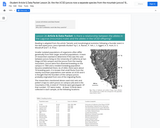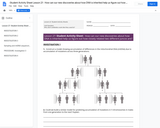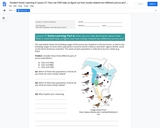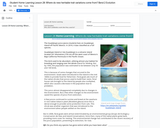
Is there a relationship between the alleles in the Lagunas (mountain) males and the alleles in the UCSD offspring?
- Subject:
- Biology
- Science
- Material Type:
- Activity/Lab
- Provider:
- iHub
- Date Added:
- 08/29/2019

Is there a relationship between the alleles in the Lagunas (mountain) males and the alleles in the UCSD offspring?

Scientists have investigated how often mutations occur in many organisms. How often a mutation appears in the DNA of the organism or in the gene pool of a larger population of that organism is referred to as the mutation rate. Compare information in charts about DNA.

Some of these populations of juncos are considered separate species. Patterns in haplotypes found in juncos mtDNA helped us determine which ones shared a common ancestor more recently than others.

Review all diagrams and charts for Investigations 1 through 4 for junco populations DNA.

Construct a model showing accumulation of differences in the mitochondrial DNA (mtDNA) due to accumulation of mutations across three generations.

Compare mutations in mitochondrial DNA between different juncos.

How could natural selection lead to all these different populations of juncos?

Circle the haplotypes in the chart.

Is it possible that new heritable trait variations (new alleles) can appear that were never in the population before?

Explore all three investigations data charts and videos to summarize information about heritable trait variations.

The Guadalupe junco (Junco insularis) lives on Guadalupe Island off Pacific Mexico. In 2016, it was classified as a full species. This lesson explore this junco plus other bird and animal species.

Random mustations in the DNA that offspring inherit are rare, but can appear in either asexual and sexually reproducing organisms. Small random mutations can result in the emergence of new traits.

Species go extinct when traits that are well adapted to a changed environment do not exist in the population. When this happens, it can open up opportunities for new species to emerge to take advantage of available resources needed for survival and reproduction that used to be consumed by the now extinct species. We think our model of evolution that we developed can explain how all life on Earth has changed over many millions of years.

Review map diagram relating to migration and human evolution (Neanderthals are discussed).

What we know about Neanderthals comes from skeletal remains and tools they left behind, as well as recent DNA comparisons we have been able to make from their bones.


Investigate history of resistance to bacteria.

What are some other experiences you’ve had where you thought you might have picked up an illness from something else in the environment around you or places you are worried that you could pick up an infection or illness?

Our goal was to determine the diversity and abundance of Staphylococcus bacteria on different components of a public transportation system in a mid-sized US city (Portland, Oregon) and to examine the level of drug resistance in these bacteria.

During the past four decades, methicillin-resistant Staphylococcus aureus, or MRSA, has evolved from a controllable nuisance into a serious public health concern. MRSA is largely a hospital-acquired infection, in fact, one of the most common. Recently, however, new strains have emerged in the community that are capable of causing severe infections in otherwise healthy people.